Laboratory of Strong Magnetic Fields
Laboratory Staff
Selected Publications
The Laboratory of Strong Magnetic Fields was organized by Academician Leonid Vasil’evich Kirensky in 1969. Then, it was led by G. S. Veisig, B. P. Khrustalev, and M. I. Petrov. Since 2010, the Laboratory has been headed by Kirill A. Shaikhutdinov.
Research Focus
- development of the techniques for inducing strong pulsed magnetic fields;
- development of the methods for studying physical properties of solids in strong pulsed and stationary magnetic fields;
- study of magnetic and magnetotransport properties of single-crystal and cluster magnets, high-temperature superconductors, substituted lanthanum manganites; investigations of orientational transitions in encapsulated liquid crystals in magnetic fields.
Advanced developments

We studied temperature dependences of resistivity of the Y3/4Lu1/4Ba2Cu3O7 + CuO и Y3/4Lu1/4Ba2Cu3O7 + BaPbO3 composites at different values and orientations of a magnetic field and transport current. These composites represent a network of the Josephson transitions and exhibit the significant magnetoresistive effect at the liquid nitrogen boiling temperature, which is useful for application of the HTS composites as high-sensitivity magnetic-field sensors. We established that the magnetoresistance of these materials is sensitive to mutual orientation of the transport current and magnetic field.
We found that the magnetoresistance depending on angle θ between the transport current and magnetic field directions is proportional to sin2θ. It means that the HTS-based composites representing a network of the Josephson junctions can detect not only the value but also the vector of magnetic induction. In order to explain the hysteresis behavior of magnetoresistance of granular HTS materials and its correlation with the magnetic hysteresis, we measured the dependences of magnetoresistance R(H) and critical current Ic(H) of the composites consisting of the Y3/4Lu1/4Ba2Cu3O7 HTS and CuO. In such composites, the network of Josephson junctions is implemented; the non-superconducting element plays the role of barriers between HTS grains.
We analyzed the hysteresis dependences of magnetoresistance R(H) in a wide range of transport current density j within the two-stage model of a granular HTS. In this model, dissipation occurs in the Josephson medium and the magnetic flux can be fixed in both grains and the Josephson medium. We experimentally demonstrated the correlation between the critical current hysteresis Ic(H) and the evolution of the hysteresis dependence of magnetoresistance R(H) upon the transport current variations. We studied the effect of magnetic prehistory on the hysteresis behavior R(H) and the appearance of the negative magnetoresistance portion.
For the first time, we showed that the dependences R(H) are characterized by the transport-current-independent parameter: the hysteresis loop width. This is illustrated in Figs. 1a and 1b. Figure 1a presents the hysteresis dependences R(H) for the YBCO + 30CuO sample at different values of transport current I (2, 4, 7, and 10 mA upward) and maximum applied field Hmax = 1, 2, 3,…7 kOe at T = 4.2 K. Figure 1b shows the magnetoresistance hysteresis width ΔHR=const = H↓ - H↑at R = const (transport currents of 2-10 mA) as a function of H↓ for the R(H) data of the YBCO + 30CuO sample from Fig. 1a. It can be seen that the magnetoresistance hysteresis is determined only by the magnetic flux trapped in superconducting grains and the effect of capture of the magnetic flux in the Josephson medium is insignificant for the hysteresis of the transport properties of the objects under investigation.
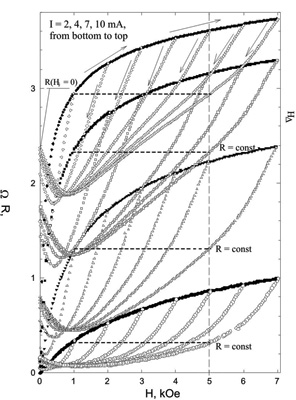 |
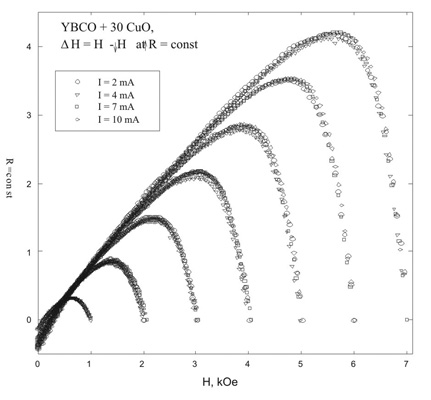 |
|
Fig. 1a. Dependences R(H) for the YBCO + 30vol. %CuO |
Fig. 1b. The magnetoresistance hysteresis width ΔHR=const = H↓ - H↑ at R = const (transport current of 2--10 mA) as a function of H↓ for the R(H) data of the YBCO + 30vol. %CuO sample from Fig. 1a. |
We thoroughly investigated current-voltage characteristics (CVCs) of the substituted single-crystal, polycrystalline, and thin-film lanthanum manganites in wide ranges of temperature (77.4 - 300 K), magnetic field (0 - 25 T), and apparatus current (up to 1A). These experiments were aimed mainly at clarifying the effect of the transport current and applied electric field on resistivity of these materials. We attempted to elucidate whether the well-known mechanism of the charge ordering break in dielectric regions occurring due to phase stratification of manganites is implemented here. We found that the CVCs have a negative differential resistivity portion (the current switching effect). Below the metal-dielectric transition temperature, the hysteresis is observed in the CVCs of all the samples. Meanwhile, the detailed analysis of the sample internal self-heating effect on the basis of experimental data on thermal conductivity showed that such CVCs are explained by nonequilibrium heating of electron gas (hot electron model) and the formation of current braids inside the sample. As an example, Fig. 2a shows experimental CVCs of single-crystal (La0.5Eu0.5)0.7Pb0.3MnO3 at different temperatures and Fig. 2b, the CVCs simulated within the model of nonequilibrium heating of electron gas.
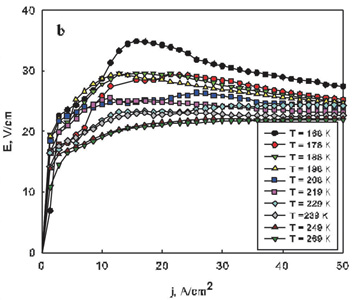 |
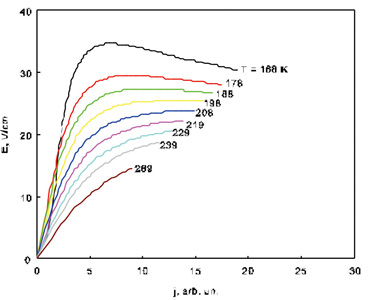 |
| Fig.2.a | Fig.2b |
Using the magnetooptical methods, we studied nemaitc liquid crystal ordering on the surface of a gel-like polymer solidified in orienting magnetic field. At this preparation technique, the domain structure forms in the nematic due to the phase transformations caused by the spinodal decay of the two-phase polymer-solvent system. Domains are planar-oriented, since during observation in the polarized current upon rotation of a polarizer by 90˚, they follow the variation in the color intensity of a dye embedded in the nematic matrix (Fig. 3). The LC director is oriented in domains along the field lines and the order parameter depends on the field strength (Fig. 4).
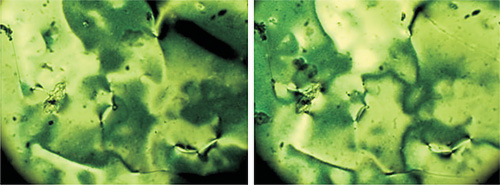
Fig. 3. Transformation of the domain structure of the doped 5CB nematic observed in a polarizing microscope at a polarizer rotation by 90°. The cell is formed upon phase stratification of the LC and polymer in zero magnetic field. The light wave vector is parallel (on the left) and perpendicular (on the right) to the magnetic field direction.
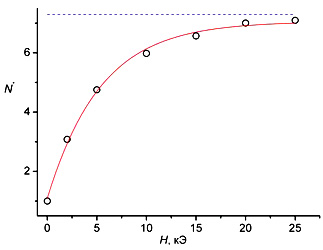 |
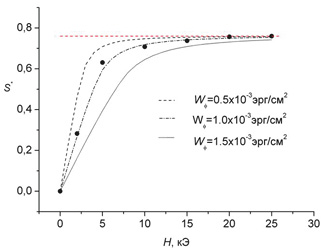 |
|
Fig. 4. Integral dichroism N* (o) of impurity absorption for the series of polydomain LC cells prepared in different magnetic fields H. The solid line corresponds to the interpolation. The horizontal line marks the limit of the variation in this value corresponding to dichroism N of the calibration LC cell. |
Fig. 5. Experimental (dots) and theoretically calculated (lines) dependences of order parameter S* of a KD-10 dye in the 5CB matrix on orienting magnetic field H. The dashed horizontal line corresponds to the orientational order parameter of the impurity dye obtained from the measured dichroism of a single-domain sample. |
In fields of Н ≥ 20 kOe, single-domain nematic LC layers form. After switching the field off, the LC remains uniformly oriented along a specified direction.
The dependence of order parameter S* of dye molecules in the LC matrix on orienting magnetic field H at different azimuth anchoring energy Wφ shows the dynamics of the ordering of LC molecules (Fig. 5).
The experimental dependence of order parameter S* is close to the calculated one at Wφ = 1x10-3 erg/cm2. This result indicates that the LC orientation in domain formations in a magnetic field occurs at a finite, relatively small anchoring energy. The degree of orientational order in the LC is related to continuous sliding of the director over the polymer surface solidified in a magnetic field. The nematic ordering under the conditions of phase stratification strongly differs from the well-known mechanism of rigid LC anchoring on smooth surfaces upon cooling of the nematic in a magnetic field [J. Cheng, G.D. Boyd, Appl. Phys. Lett., 35, P. 444, (1979)].
Equipment
- Vibrating sample magnetometer with a superconducting solenoid for measuring magnetization and magnetic susceptibility at temperatures of 2--400 K in magnetic fields up to 70 kOe.
- Vibrating sample magnetometer with a superconducting solenoid for measuring magnetization and magnetic susceptibility at temperatures of 2--400 K in magnetic fields up to 70 kOe.
- System for studying optical absorption of encapsulated liquid crystals in pulsed magnetic fields up to 200 kOe.
- FL-1-electromagnet-based system for studying magnetotransport properties of solids at temperatures 77.4--350 K in magnetic fields up to 15 kOe.
All the listed equipment is fully automated.

